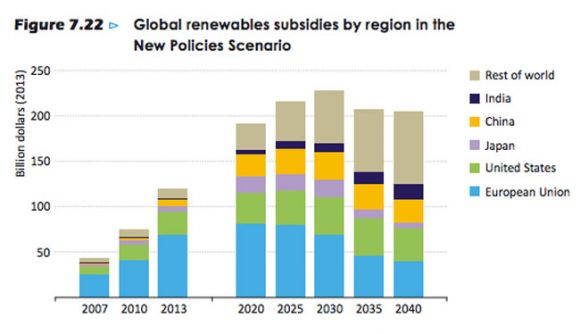Countries around the globe have committed to reducing subsidies for fossil fuels, primarily oil and gas. But that commitment is not being put into practice quickly enough for cleaner energy solutions to gain a competitive edge in some regions, according to the 2014 World Energy Outlook from the International Energy Agency.
Global subsidies for fossil fuels totaled nearly $550 billion in 2013. That figure is $25 billion lower than that of the previous year, but the IEA notes that is still not enough of a shift to make renewable energy competitive in the countries with the highest subsidies.
More than half of the world’s fossil-fuel subsidies go to oil, and many of the subsidies are concentrated in oil- and gas-producing countries in the Middle East and North Africa.
The subsidies that go to fossil fuels dwarf the subsidies for renewable energies, which the IEA put at $120 billion in 2013. The U.S. had about $27 billion in renewable subsidies in 2013, mostly going to solar PV, wind and biofuels.
In the Middle East, more than one-third of all electricity is generated with subsidized oil. Without subsidies, all mainstream low-carbon energy technologies -- including nuclear -- would be cost-competitive with oil generation.
The picture varies country by country. In Russia, for example, the IEA found that most non-hydro renewables except for onshore wind would struggle to compete even in the absence of gas subsidies.
“One thing is certain,” the report authors state. “The cost of fossil fuels to an economy is not reduced by subsidies; it is just redistributed.” The IEA found that only 8 percent of the money spent on fossil-fuel subsidies reaches the poorest 20 percent of the population.
It is not just renewable energy that is losing out to fossil fuels because of subsidies. Energy-efficient technologies, such as LEDs, are far less attractive in regions where oil and gas are heavily subsidized. In the Middle East, the payback for LEDs is approximately a decade, compared to less than two years if electricity rates reflected the real cost of supply.
Many of the countries that lean heavily on subsidies are instituting some reform, mostly because there simply isn’t enough money in the government coffers to support the subsidies anymore.
Although some of the countries that heavily subsidize oil or gas are also investing in renewables, such as Saudi Arabia, often they are not subsidizing renewables at nearly the same rate as they do fossil fuels, nor will they be in the future, according to the IEA.

Source: OECD/IEA 2014
The IEA does not call for an end to all energy subsidies, but rather for the implementation of an approach that would end those subsidies for fossil fuels while encouraging tailored price breaks for renewables.
“Fossil-fuel subsidies rig the game against renewables and act as a drag on the transition to a more sustainable energy system,” the IEA states. “On the other hand, subsidies to renewables can, if well designed, aid the deployment of sustainable technologies in support of energy security and environmental goals.”
Even if action to dismantle subsidies is slow to transpire in oil- and gas-rich countries, there are other moves afoot that could boost the increasing cost-competitiveness of some forms of renewable energy. On Wednesday, China and the U.S. announced an agreement on joint targets for reducing carbon dioxide emissions.
In the U.S., fossil-fuel subsidies also might not get a free pass with the newly Republican-controlled Congress. Earlier this year, Rep. Dave Camp (R-MI) introduced a tax reform bill that removed subsidies for many energy technologies, including oil, gas and coal.
Even without substantial reform on fossil-fuel subsidies, the IEA forecasts that nearly half of the world’s increase in electricity generation between now and 2040 will come from renewables.



